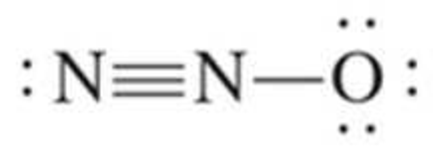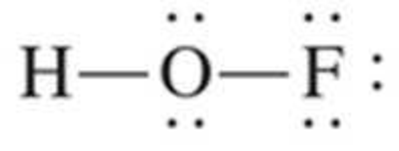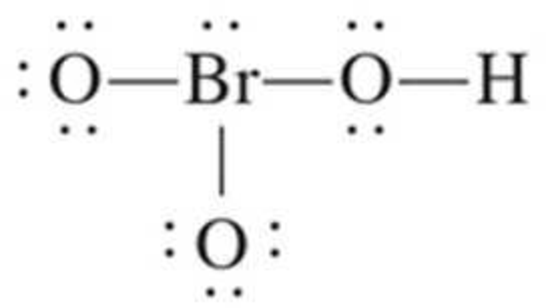
Bundle: General, Organic, and Biological Chemistry, 7th + OWLv2 Quick Prep for General Chemistry, 4 terms (24 months) Printed Access Card
7th Edition
ISBN: 9781305717534
Author: H. Stephen Stoker
Publisher: Cengage Learning
expand_more
expand_more
format_list_bulleted
Concept explainers
Textbook Question
Chapter 5, Problem 5.25EP
Identify the coordinate covalent bond(s) present, if any in each of the following molecules by listing the two atoms involved in the bond. Name the atom on the left or the bottom in the bond first.




Expert Solution & Answer
Trending nowThis is a popular solution!

Students have asked these similar questions
Could you redraw these and also explain how to solve them for me pleas
None
Draw the curved-arrow mechanism with the drawings of the molecules, not
just abbreviations.
-NO₂
Sn, HCl (aq)
E
D
H
(CH3CO)₂O
-NH2
CH3
Chapter 5 Solutions
Bundle: General, Organic, and Biological Chemistry, 7th + OWLv2 Quick Prep for General Chemistry, 4 terms (24 months) Printed Access Card
Ch. 5.1 - Covalent bond formation most often involves...Ch. 5.1 - Which of the following concepts is closely...Ch. 5.1 - Prob. 3QQCh. 5.1 - Prob. 4QQCh. 5.2 - Prob. 1QQCh. 5.2 - Prob. 2QQCh. 5.2 - Prob. 3QQCh. 5.2 - Prob. 4QQCh. 5.2 - Prob. 5QQCh. 5.2 - Prob. 6QQ
Ch. 5.3 - Prob. 1QQCh. 5.3 - Prob. 2QQCh. 5.3 - Prob. 3QQCh. 5.3 - Prob. 4QQCh. 5.3 - Prob. 5QQCh. 5.4 - Prob. 1QQCh. 5.4 - Prob. 2QQCh. 5.4 - Prob. 3QQCh. 5.5 - Which of the following is an incorrect statement...Ch. 5.5 - Prob. 2QQCh. 5.5 - Prob. 3QQCh. 5.6 - Prob. 1QQCh. 5.6 - Prob. 2QQCh. 5.6 - Prob. 3QQCh. 5.6 - Prob. 4QQCh. 5.6 - Prob. 5QQCh. 5.7 - Prob. 1QQCh. 5.7 - Prob. 2QQCh. 5.7 - Prob. 3QQCh. 5.8 - Prob. 1QQCh. 5.8 - In VSEPR theory, an angular molecular geometry is...Ch. 5.8 - Prob. 3QQCh. 5.8 - Prob. 4QQCh. 5.8 - Prob. 5QQCh. 5.9 - Prob. 1QQCh. 5.9 - Prob. 2QQCh. 5.9 - Prob. 3QQCh. 5.9 - Prob. 4QQCh. 5.10 - Prob. 1QQCh. 5.10 - Prob. 2QQCh. 5.10 - Prob. 3QQCh. 5.10 - As the difference in electronegativity between two...Ch. 5.10 - Prob. 5QQCh. 5.10 - Prob. 6QQCh. 5.11 - Prob. 1QQCh. 5.11 - Prob. 2QQCh. 5.11 - Prob. 3QQCh. 5.11 - Prob. 4QQCh. 5.11 - Prob. 5QQCh. 5.12 - Prob. 1QQCh. 5.12 - Prob. 2QQCh. 5.12 - Prob. 3QQCh. 5.12 - Prob. 4QQCh. 5.12 - Prob. 5QQCh. 5.12 - Prob. 6QQCh. 5 - Contrast the types of elements involved in ionic...Ch. 5 - Contrast the mechanisms by which ionic and...Ch. 5 - Prob. 5.3EPCh. 5 - Prob. 5.4EPCh. 5 - Indicate whether or not covalent bond formation is...Ch. 5 - Indicate whether or not covalent bond formation is...Ch. 5 - Draw Lewis structures to illustrate the covalent...Ch. 5 - Draw Lewis structures to illustrate the covalent...Ch. 5 - How many nonbonding electron pairs are present in...Ch. 5 - How many nonbonding electron pairs are present in...Ch. 5 - The component elements for four binary molecular...Ch. 5 - The component elements for four binary molecular...Ch. 5 - Specify the number of single, double, and triple...Ch. 5 - Specify the number of single, double, and triple...Ch. 5 - Convert each of the Lewis structures in Problem...Ch. 5 - Convert each of the Lewis structures in Problem...Ch. 5 - Prob. 5.17EPCh. 5 - Prob. 5.18EPCh. 5 - Prob. 5.19EPCh. 5 - Identify the Period 3 nonmetal that would normally...Ch. 5 - How many valence electrons do atoms possess that...Ch. 5 - Prob. 5.22EPCh. 5 - What aspect of the following Lewis structure...Ch. 5 - What aspect of the following Lewis structure...Ch. 5 - Identify the coordinate covalent bond(s) present,...Ch. 5 - Identify the coordinate covalent bond(s) present,...Ch. 5 - Without actually drawing the Lewis structure,...Ch. 5 - Without actually drawing the Lewis structure,...Ch. 5 - Prob. 5.29EPCh. 5 - Prob. 5.30EPCh. 5 - Draw the Lewis structure for each of the molecules...Ch. 5 - Draw the Lewis structure for each of the molecules...Ch. 5 - Draw Lewis structures to illustrate the bonding in...Ch. 5 - Draw Lewis structures to illustrate the bonding in...Ch. 5 - How many electron dots should appear in the Lewis...Ch. 5 - Prob. 5.36EPCh. 5 - Draw Lewis structures for the following polyatomic...Ch. 5 - Draw Lewis structures for the following polyatomic...Ch. 5 - Draw Lewis structures for the following compounds...Ch. 5 - Draw Lewis structures for the following compounds...Ch. 5 - Draw Lewis structures for the following molecules...Ch. 5 - Draw Lewis structures for the following molecules...Ch. 5 - In which of the following pairs of diatomic...Ch. 5 - In which of the following pairs of diatomic...Ch. 5 - Prob. 5.45EPCh. 5 - What is the molecular geometry associated with...Ch. 5 - Specify the molecular geometry of each of the...Ch. 5 - Specify the molecular geometry of each of the...Ch. 5 - Prob. 5.49EPCh. 5 - Prob. 5.50EPCh. 5 - Prob. 5.51EPCh. 5 - Prob. 5.52EPCh. 5 - Prob. 5.53EPCh. 5 - Prob. 5.54EPCh. 5 - Using VSEPR theory, predict the molecular geometry...Ch. 5 - Using VSEPR theory, predict the molecular geometry...Ch. 5 - Prob. 5.57EPCh. 5 - Specify both the VSEPR electron group geometry...Ch. 5 - Prob. 5.59EPCh. 5 - Prob. 5.60EPCh. 5 - Using a periodic table, but not a table of...Ch. 5 - Using a periodic table, but not a table of...Ch. 5 - Prob. 5.63EPCh. 5 - Prob. 5.64EPCh. 5 - Place + above the atom that is relatively positive...Ch. 5 - Place + above the atom that is relatively positive...Ch. 5 - Rank the following bonds in order of increasing...Ch. 5 - Rank the following bonds in order of increasing...Ch. 5 - Classify each of the following bonds as nonpolar...Ch. 5 - Classify each of the following bonds as nonpolar...Ch. 5 - Prob. 5.71EPCh. 5 - Prob. 5.72EPCh. 5 - Fill in the blanks in each line of the following...Ch. 5 - Fill in the blanks in each line of the following...Ch. 5 - Four hypothetical elements, A, B, C, and D, have...Ch. 5 - Four hypothetical elements, A, B, C, and D, have...Ch. 5 - Indicate whether each of the following...Ch. 5 - Prob. 5.78EPCh. 5 - Indicate whether each of the following triatomic...Ch. 5 - Indicate whether each of the following triatomic...Ch. 5 - Indicate whether each of the following molecules...Ch. 5 - Indicate whether each of the following molecules...Ch. 5 - Prob. 5.83EPCh. 5 - Prob. 5.84EPCh. 5 - Indicate which molecule in each of the following...Ch. 5 - Indicate which molecule in each of the following...Ch. 5 - Successive substitution of F atoms for H atoms in...Ch. 5 - Successive substitution of F atoms for H atoms in...Ch. 5 - Prob. 5.89EPCh. 5 - Indicate whether or not each of the following...Ch. 5 - Prob. 5.91EPCh. 5 - Name the following binary molecular compounds? a....Ch. 5 - Prob. 5.93EPCh. 5 - Prob. 5.94EPCh. 5 - Prob. 5.95EPCh. 5 - Prob. 5.96EPCh. 5 - Prob. 5.97EPCh. 5 - Prob. 5.98EPCh. 5 - Write chemical formulas for the following binary...Ch. 5 - Write chemical formulas for the following binary...Ch. 5 - Prob. 5.101EPCh. 5 - Prob. 5.102EPCh. 5 - The compound whose molecles contain one atom of C...Ch. 5 - Prob. 5.104EPCh. 5 - Prob. 5.105EPCh. 5 - The correct name for the compound K2SO4 is not...Ch. 5 - Prob. 5.107EPCh. 5 - Prob. 5.108EP
Knowledge Booster
Learn more about
Need a deep-dive on the concept behind this application? Look no further. Learn more about this topic, chemistry and related others by exploring similar questions and additional content below.Similar questions
- What is/are the product(s) of the following reaction? Select all that apply. * HI A B C OD OH A B OH D Carrow_forwardIn the image, the light blue sphere represents a mole of hydrogen atoms, the purple or teal spheres represent a mole of a conjugate base. A light blue sphere by itself is H+. Assuming there is 2.00 L of solution, answer the following: The Ka of the left & right solution is? The pH of the left & right solution is? The acid on the left & right is what kind of acid?arrow_forwardNonearrow_forward
- Nonearrow_forwardNonearrow_forwardWhat spectral features allow you to differentiate the product from the starting material? Use four separate paragraphs for each set of comparisons. You should have one paragraph each devoted to MS, HNMR, CNMR and IR. 2) For MS, the differing masses of molecular ions are a popular starting point. Including a unique fragmentation is important, too. 3) For HNMR, CNMR and IR state the peaks that are different and what makes them different (usually the presence or absence of certain groups). See if you can find two differences (in each set of IR, HNMR and CNMR spectra) due to the presence or absence of a functional group. Include peak locations. Alternatively, you can state a shift of a peak due to a change near a given functional group. Including peak locations for shifted peaks, as well as what these peaks are due to. Ideally, your focus should be on not just identifying the differences but explaining them in terms of functional group changes.arrow_forward
- Nonearrow_forwardNonearrow_forwardIn the solid state, oxalic acid occurs as a dihydrate with the formula H2C2O4 C+2H2O. Use this formula to calculate the formula weight of oxalic acid. Use the calculated formula weight and the number of moles (0.00504mol) of oxalic acid in each titrated unknown sample recorded in Table 6.4 to calculate the number of grams of pure oxalic acid dihydrate contained in each titrated unknown sample.arrow_forward
arrow_back_ios
SEE MORE QUESTIONS
arrow_forward_ios
Recommended textbooks for you
 General, Organic, and Biological ChemistryChemistryISBN:9781285853918Author:H. Stephen StokerPublisher:Cengage LearningChemistry: Matter and ChangeChemistryISBN:9780078746376Author:Dinah Zike, Laurel Dingrando, Nicholas Hainen, Cheryl WistromPublisher:Glencoe/McGraw-Hill School Pub Co
General, Organic, and Biological ChemistryChemistryISBN:9781285853918Author:H. Stephen StokerPublisher:Cengage LearningChemistry: Matter and ChangeChemistryISBN:9780078746376Author:Dinah Zike, Laurel Dingrando, Nicholas Hainen, Cheryl WistromPublisher:Glencoe/McGraw-Hill School Pub Co Introductory Chemistry: An Active Learning Approa...ChemistryISBN:9781305079250Author:Mark S. Cracolice, Ed PetersPublisher:Cengage Learning
Introductory Chemistry: An Active Learning Approa...ChemistryISBN:9781305079250Author:Mark S. Cracolice, Ed PetersPublisher:Cengage Learning Chemistry: The Molecular ScienceChemistryISBN:9781285199047Author:John W. Moore, Conrad L. StanitskiPublisher:Cengage Learning
Chemistry: The Molecular ScienceChemistryISBN:9781285199047Author:John W. Moore, Conrad L. StanitskiPublisher:Cengage Learning Living By Chemistry: First Edition TextbookChemistryISBN:9781559539418Author:Angelica StacyPublisher:MAC HIGHER
Living By Chemistry: First Edition TextbookChemistryISBN:9781559539418Author:Angelica StacyPublisher:MAC HIGHER Chemistry & Chemical ReactivityChemistryISBN:9781337399074Author:John C. Kotz, Paul M. Treichel, John Townsend, David TreichelPublisher:Cengage Learning
Chemistry & Chemical ReactivityChemistryISBN:9781337399074Author:John C. Kotz, Paul M. Treichel, John Townsend, David TreichelPublisher:Cengage Learning

General, Organic, and Biological Chemistry
Chemistry
ISBN:9781285853918
Author:H. Stephen Stoker
Publisher:Cengage Learning

Chemistry: Matter and Change
Chemistry
ISBN:9780078746376
Author:Dinah Zike, Laurel Dingrando, Nicholas Hainen, Cheryl Wistrom
Publisher:Glencoe/McGraw-Hill School Pub Co

Introductory Chemistry: An Active Learning Approa...
Chemistry
ISBN:9781305079250
Author:Mark S. Cracolice, Ed Peters
Publisher:Cengage Learning

Chemistry: The Molecular Science
Chemistry
ISBN:9781285199047
Author:John W. Moore, Conrad L. Stanitski
Publisher:Cengage Learning

Living By Chemistry: First Edition Textbook
Chemistry
ISBN:9781559539418
Author:Angelica Stacy
Publisher:MAC HIGHER

Chemistry & Chemical Reactivity
Chemistry
ISBN:9781337399074
Author:John C. Kotz, Paul M. Treichel, John Townsend, David Treichel
Publisher:Cengage Learning
Types of bonds; Author: Edspira;https://www.youtube.com/watch?v=Jj0V01Arebk;License: Standard YouTube License, CC-BY